A Scientometric Analysis of Climate Change Adaptation Studies
Abstract
1. Introduction
2. Materials and Methods
3. Results
3.1. Climate Change Adaptation
3.2. Disaster Risk Reduction
3.3. Sustainable Agricultural Practices
3.4. Circular Economy
4. Discussion
5. Conclusions
Author Contributions
Funding
Institutional Review Board Statement
Informed Consent Statement
Data Availability Statement
Conflicts of Interest
References
- Smith, J.B.; Lenhart, S.S. Climate change adaptation policy options. Clim. Res. 1996, 6, 193–201. [Google Scholar] [CrossRef]
- Fankhauser, S. Adaptation to Climate Change. Annu. Rev. Resour. Econ. 2017, 9, 209–230. [Google Scholar] [CrossRef]
- Neset, T.-S.; Opach, T.; Lion, P.; Lilja, A.; Johansson, J. Map-Based Web Tools Supporting Climate Change Adaptation. Prof. Geogr. 2016, 68, 103–114. [Google Scholar] [CrossRef]
- Carrico, A.R.; Truelove, H.B.; Vandenbergh, M.P.; Dana, D. Does learning about climate change adaptation change support for mitigation? J. Environ. Psychol. 2015, 41, 19–29. [Google Scholar] [CrossRef]
- Biesbroek, G.R.; Swart, R.J.; Carter, T.R.; Cowan, C.; Henrichs, T.; Mela, H.; Morecroft, M.D.; Rey, D. Europe adapts to climate change: Comparing National Adaptation Strategies. Glob. Environ. Change-Hum. Policy Dimens. 2010, 20, 440–450. [Google Scholar] [CrossRef]
- Bouwer, L.M.; Aerts, J.C.J.H. Financing climate change adaptation. Disasters 2006, 30, 49–63. [Google Scholar] [CrossRef]
- Prasad, R.S.; Sud, R. Implementing climate change adaptation: Lessons from India’s national adaptation fund on climate change (NAFCC). Clim. Policy 2019, 19, 354–366. [Google Scholar] [CrossRef]
- Wise, R.M.; Fazey, I.; Smith, M.S.; Park, S.E.; Eakin, H.C.; Van Garderen, E.R.M.A.; Campbell, B. Reconceptualising adaptation to climate change as part of pathways of change and response. Glob. Environ. Change-Hum. Policy Dimens. 2014, 28, 325–336. [Google Scholar] [CrossRef]
- Wiréhn, L. Nordic agriculture under climate change: A systematic review of challenges, opportunities and adaptation strategies for crop production. Land Use Policy 2018, 77, 63–74. [Google Scholar] [CrossRef]
- Macintosh, A.; Foerster, A.; McDonald, J. Policy design, spatial planning and climate change adaptation: A case study from Australia. J. Environ. Plan. Manag. 2015, 58, 1432–1453. [Google Scholar] [CrossRef]
- Timilsina, G.R. Financing Climate Change Adaptation: International Initiatives. Sustainability 2021, 13, 6515. [Google Scholar] [CrossRef]
- Xiao, X.; Perry, E.E.; Gao, J.; Lu, J.; Manning, R. Winter tourism and climate change: Exploring local and non-local snowmobilers’ perceptions of climate change and adaptation behaviors. J. Outdoor Recreat. Tour. 2020, 31, 100299. [Google Scholar] [CrossRef]
- Bator, A.; Borek, A. Adaptation to Climate Change under Climate Change Treaties. Int. Community Law Rev. 2021, 23, 158–167. [Google Scholar] [CrossRef]
- Neset, T.-S.; Glaas, E.; Ballantyne, A.G.; Linnér, B.-O.; Opach, T.; Navarra, C.; Johansson, J.; Bohman, A.; Rød, J.K.; Goodsite, M. Climate change effects at your doorstep: Geographic visualization to support Nordic homeowners in adapting to climate change. Appl. Geogr. 2016, 74, 65–72. [Google Scholar] [CrossRef]
- Peñalba, L.M.; Elazegui, D.D.; Pulhin, J.M.; Cruz, R.V.O. Social and institutional dimensions of climate change adaptation. Int. J. Clim. Change Strateg. Manag. 2012, 4, 308–322. [Google Scholar] [CrossRef]
- Pearce-Higgins, J.; Antão, L.; Bates, R.; Bowgen, K.; Bradshaw, C.; Duffield, S.; Ffoulkes, C.; Franco, A.; Geschke, J.; Gregory, R.; et al. A framework for climate change adaptation indicators for the natural environment. Ecol. Indic. 2022, 136, 108690. [Google Scholar] [CrossRef]
- Fu, L.; Cao, Y.; Kuang, S.-Y.; Guo, H. Index for climate change adaptation in China and its application. Adv. Clim. Change Res. 2021, 12, 723–733. [Google Scholar] [CrossRef]
- Werners, S.E.; van Slobbe, E.; Bolscher, T.; Oost, A.; Pfenninger, S.; Trombi, G.; Bindi, M.; Moriondo, M. Turning points in climate change adaptation. Ecol. Soc. 2016, 20, 3. Available online: http://www.jstor.org/stable/26270274 (accessed on 17 June 2022). [CrossRef]
- Juhola, S.; Klein, N.; Käyhkö, J.; Neset, T.-S.S. Climate change transformations in Nordic agriculture? J. Rural Stud. 2017, 51, 28–36. [Google Scholar] [CrossRef]
- Paterson, J.A.; Ford, J.D.; Ford, L.B.; Lesnikowski, A.; Berry, P.; Henderson, J.; Heymann, J. Adaptation to climate change in the Ontario public health sector. BMC Public Health 2012, 12, 452. [Google Scholar] [CrossRef]
- Macheka, L.; Mudiwa, T.; Chopera, P.; Nyamwanza, A.; Jacobs, P. Linking Climate Change Adaptation Strategies and Nutrition Outcomes: A Conceptual Framework. Food Nutr. Bull. 2022, 43, 201–212. [Google Scholar] [CrossRef] [PubMed]
- Orlowsky, B.; Calanca, P.; Ali, I.; Ali, J.; Hilares, A.E.; Huggel, C.; Khan, I.; Neukom, R.; Nizami, A.; Qazi, M.A.; et al. Climate corridors for strategic adaptation planning. Int. J. Clim. Change Strateg. Manag. 2017, 9, 811–828. [Google Scholar] [CrossRef]
- Hackenbruch, J.; Kunz-Plapp, T.; Müller, S.; Schipper, J.W. Tailoring Climate Parameters to Information Needs for Local Adaptation to Climate Change. Climate 2017, 5, 25. [Google Scholar] [CrossRef]
- Tompkins, E.L.; Adger, W.N.; Boyd, E.; Nicholson-Cole, S.; Weatherhead, E.K.; Arnell, N. Observed adaptation to climate change: UK evidence of transition to a well-adapting society. Glob. Environ. Change 2010, 20, 627–635. [Google Scholar] [CrossRef]
- Joakim, E.P.; Mortsch, L.; Oulahen, G. Using vulnerability and resilience concepts to advance climate change adaptation. Environ. Hazards 2015, 14, 137–155. [Google Scholar] [CrossRef]
- Pearce, T.; Ford, J.D.; Caron, A.; Kudlak, B.P. Climate change adaptation planning in remote, resource-dependent communities: An Arctic example. Reg. Environ. Change 2012, 12, 825–837. [Google Scholar] [CrossRef]
- Delaporte, I.; Maurel, M. Adaptation to climate change in Bangladesh. Clim. Policy 2018, 18, 49–62. [Google Scholar] [CrossRef]
- Paavola, J.; Adger, W.N. Fair adaptation to climate change. Ecol. Econ. 2006, 56, 594–609. [Google Scholar] [CrossRef]
- Adger, W.N.; Brown, I.; Surminski, S. Advances in risk assessment for climate change adaptation policy. Philos. Trans. R. Soc. Lond. Ser. A Math. Phys. Eng. Sci. 2018, 376, 20180106. [Google Scholar] [CrossRef]
- Dorward, P.; Osbahr, H.; Sutcliffe, C.; Mbeche, R. Supporting climate change adaptation using historical climate analysis. Clim. Dev. 2019, 12, 469–480. [Google Scholar] [CrossRef]
- Keskitalo, E.C.H.; Bergh, J.; Felton, A.; Björkman, C.; Berlin, M.; Axelsson, P.; Ring, E.; Ågren, A.; Roberge, J.-M.; Klapwijk, M.J.; et al. Adaptation to Climate Change in Swedish Forestry. Forests 2016, 7, 28. [Google Scholar] [CrossRef]
- Bedsworth, L.W.; Hanak, E. Adaptation to Climate Change. J. Am. Plan. Assoc. 2010, 76, 477–495. [Google Scholar] [CrossRef]
- Biesbroek, G.R.; Klostermann, J.E.M.; Termeer, C.J.A.M.; Kabat, P. On the nature of barriers to climate change adaptation. Reg. Environ. Change 2013, 13, 1119–1129. [Google Scholar] [CrossRef]
- Füssel, H.-M. Adaptation planning for climate change: Concepts, assessment approaches, and key lessons. Sustain. Sci. 2007, 2, 265–275. [Google Scholar] [CrossRef]
- Iwami, A.; Matsui, T.; Kimura, M.; Baba, K.; Tanaka, M. Organizing the Challenges Faced by Municipalities while Formulating Climate Change Adaptation Plans. Sustainability 2020, 12, 1203. [Google Scholar] [CrossRef]
- Thayer, A.W.; Vargas, A.; Castellanos, A.A.; Lafon, C.W.; McCarl, B.A.; Roelke, D.L.; Winemiller, K.O.; Lacher, T.E. Integrating Agriculture and Ecosystems to Find Suitable Adaptations to Climate Change. Climate 2020, 8, 10. [Google Scholar] [CrossRef]
- Shearer, H.; Coiacetto, E.; Dodson, J.; Taygfeld, P. How the structure of the Australian housing development industry influences climate change adaptation. Hous. Stud. 2016, 31, 809–828. [Google Scholar] [CrossRef]
- Warren, R.F.; Wilby, R.L.; Brown, K.; Watkiss, P.; Betts, R.A.; Murphy, J.M.; Lowe, J.A. Advancing national climate change risk assessment to deliver national adaptation plans. Philos. Trans. R. Soc. Lond. Ser. A Math. Phys. Eng. Sci. 2018, 376, 20170295. [Google Scholar] [CrossRef]
- Panda, A. Transformational adaptation of agricultural systems to climate change. WIREs Clim. Change 2018, 9, e520. [Google Scholar] [CrossRef]
- Wang, X.-J.; Zhang, J.-Y.; Shahid, S.; Guan, E.-H.; Wu, Y.-X.; Gao, J.; He, R.-M. Adaptation to climate change impacts on water demand. Mitig. Adapt. Strateg. Glob. Change 2016, 21, 81–99. [Google Scholar] [CrossRef]
- Tenzing, J.D. Integrating social protection and climate change adaptation: A review. Wiley Interdiscip. Rev.-Clim. Change 2020, 11, e626. [Google Scholar] [CrossRef]
- Rickards, L.; Howden, S.M. Transformational adaptation: Agriculture and climate change. Crop. Pasture Sci. 2012, 63, 240–250. [Google Scholar] [CrossRef]
- Stewart, M.G.; Wang, X.M.; Nguyen, M.N. Climate change adaptation for corrosion control of concrete infrastructure. Struct. Saf. 2012, 35, 29–39. [Google Scholar] [CrossRef]
- Stadler, F.; Houghton, L. Breathing life into climate change adaptation. J. Ind. Ecol. 2019, 24, 400–409. [Google Scholar] [CrossRef]
- Berrang-Ford, L.; Pearce, T.; Ford, J.D. Systematic review approaches for climate change adaptation research. Reg. Environ. Change 2015, 15, 755–769. [Google Scholar] [CrossRef]
- Scheraga, J.D.; Grambsch, A.E. Risks, opportunities, and adaptation to climate change. Clim. Res. 1998, 11, 85–95. Available online: https://www.int-res.com/abstracts/cr/v11/n1/p85-95/ (accessed on 17 June 2022). [CrossRef]
- Rosales-Torres, C.; Gijón-Rivera, C.; Garay-Rondero, C.L.; Castillo-Paz, Á.; Domínguez-Ramírez, G. Design, Experimentation and Statistical Validation of a Methodology to Solve Complex Engineering Problems in Higher Education. Sustainability 2022, 14, 2240. [Google Scholar] [CrossRef]
- Constantin, M.; Sacală, M.-D.; Dinu, M.; Piștalu, M.; Pătărlăgeanu, S.R.; Munteanu, I.-D. Vegetable Trade Flows and Chain Competitiveness Linkage Analysis Based on Spatial Panel Econometric Modelling and Porter’s Diamond Model. Agronomy 2022, 12, 411. [Google Scholar] [CrossRef]
- Pan, L.; Wang, L.; Feng, Q. A Bibliometric Analysis of Risk Management in Foreign Direct Investment: Insights and Implications. Sustainability 2022, 14, 7078. [Google Scholar] [CrossRef]
- Hussain, S.; Lu, L.; Mubeen, M.; Nasim, W.; Karuppannan, S.; Fahad, S.; Tariq, A.; Mousa, B.G.; Mumtaz, F.; Aslam, M. Spatiotemporal Variation in Land Use Land Cover in the Response to Local Climate Change Using Multispectral Remote Sensing Data. Land 2022, 11, 595. [Google Scholar] [CrossRef]
- Lu, X.F. Provision of climate information for adaptation to climate change. Clim. Res. 2011, 47, 83–94. [Google Scholar] [CrossRef]
- Nalau, J.; Verrall, B. Mapping the evolution and current trends in climate change adaptation science. Clim. Risk Manag. 2021, 32, 100290. [Google Scholar] [CrossRef]
- Eriksen, S.H.; Nightingale, A.J.; Eakin, H. Reframing adaptation: The political nature of climate change adaptation. Glob. Environ. Change 2015, 35, 523–533. [Google Scholar] [CrossRef]
- Dhar, T.K.; Khirfan, L. Climate change adaptation in the urban planning and design research: Missing links and research agenda. J. Environ. Plan. Manag. 2017, 60, 602–627. [Google Scholar] [CrossRef]
- Ollat, N.; Touzard, J.-M.; van Leeuwen, C. Climate Change Impacts and Adaptations: New Challenges for the Wine Industry. J. Wine Econ. 2016, 11, 139–149. [Google Scholar] [CrossRef]
- Biesbroek, R.; Peters, B.G.; Tosun, J. Public Bureaucracy and Climate Change Adaptation. Rev. Policy Res. 2018, 35, 776–791. [Google Scholar] [CrossRef]
- Schoenefeld, J.J.; Schulze, K.; Bruch, N. The diffusion of climate change adaptation policy. WIREs Clim. Change 2022, 13, e775. [Google Scholar] [CrossRef]
- Smith, J.B.; Dickinson, T.; Donahue, J.D.; Burton, I.; Haites, E.; Klein, R.J.; Patwardhan, A. Development and climate change adaptation funding: Coordination and integration. Clim. Policy 2011, 11, 987–1000. [Google Scholar] [CrossRef]
- Biesbroek, G.R.; Termeer, C.J.A.M.; Klostermann, J.E.M.; Kabat, P. Analytical lenses on barriers in the governance of climate change adaptation. Mitig. Adapt. Strateg. Glob. Change 2014, 19, 1011–1032. [Google Scholar] [CrossRef]
- Doroszkiewicz, J.; Romanowicz, R.J. Guidelines for the adaptation to floods in changing climate. Acta Geophys. 2017, 65, 849–861. [Google Scholar] [CrossRef]
- Berkhout, F. Rationales for adaptation in EU climate change policies. Clim. Policy 2005, 5, 377–391. [Google Scholar] [CrossRef]
- Kgosikoma, K.R.; Lekota, P.C.; Kgosikoma, O.E. Agro-pastoralists’ determinants of adaptation to climate change. Int. J. Clim. Change Strateg. Manag. 2018, 10, 488–500. [Google Scholar] [CrossRef]
- Dumitru, E.A.; Ursu, A.; Tudor, V.C.; Micu, M.M. Sustainable Development of the Rural Areas from Romania: Development of a Digital Tool to Generate Adapted Solutions at Local Level. Sustainability 2021, 13, 11921. [Google Scholar] [CrossRef]
- Iancu, T.; Petre, I.L.; Tudor, V.C.; Micu, M.M.; Ursu, A.; Teodorescu, F.-R.; Dumitru, E.A. A Difficult Pattern to Change in Romania, the Perspective of Socio-Economic Development. Sustainability 2022, 14, 2350. [Google Scholar] [CrossRef]
- Rahman, S.; Anik, A.R.; Sarker, J.R. Climate, Environment and Socio-Economic Drivers of Global Agricultural Productivity Growth. Land 2022, 11, 512. [Google Scholar] [CrossRef]
- Asseng, S.; Martre, P.; Maiorano, A.; Rötter, R.P.; O’Leary, G.J.; Fitzgerald, G.J.; Girousse, C.; Motzo, R.; Giunta, F.; Ali Babar, M.; et al. Climate Change Impact and Adaptation for Wheat Protein. Glob. Change Biol. 2018, 25, 155–173. [Google Scholar] [CrossRef]
- Banzhaf, E.; Anderson, S.; Grandin, G.; Hardiman, R.; Jensen, A.; Jones, L.; Knopp, J.; Levin, G.; Russel, D.; Wu, W.; et al. Urban-Rural Dependencies and Opportunities to Design Nature-Based Solutions for Resilience in Europe and China. Land 2022, 11, 480. [Google Scholar] [CrossRef]
- Campos, I.; Vizinho, A.; Coelho, C.; Alves, F.; Truninger, M.; Pereira, C.; Santos, F.; Penha-Lopes, G. Participation, scenarios and pathways in long-term planning for climate change adaptation. Plan. Theory Pract. 2016, 17, 537–556. [Google Scholar] [CrossRef]
- Keenan, R.J. Climate change impacts and adaptation in forest management: A review. Ann. For. Sci. 2015, 72, 145–167. [Google Scholar] [CrossRef]
- Day, E.; Fankhauser, S.; Kingsmill, N.; Costa, H.; Mavrogianni, A. Upholding labour productivity under climate change: An assessment of adaptation options. Clim. Policy 2018, 19, 367–385. [Google Scholar] [CrossRef]
- Lara, Á.; Moral, L.d. Nature-Based Solutions to Hydro-Climatic Risks: Barriers and Triggers for Their Implementation in Seville (Spain). Land 2022, 11, 868. [Google Scholar] [CrossRef]
- Schmidt-Thome, P. Towards Applying Climate Change Adaptation. Investig. Geogr.-Spain 2017, 67, 49–60. Available online: http://hdl.handle.net/10045/67568 (accessed on 17 June 2022). [CrossRef]
- Kaján, E.; Saarinen, J. Tourism, climate change and adaptation: A review. Curr. Issues Tour. 2013, 16, 167–195. [Google Scholar] [CrossRef]
- Ndue, K.; Pál, G. Life Cycle Assessment Perspective for Sectoral Adaptation to Climate Change: Environmental Impact Assessment of Pig Production. Land 2022, 11, 827. [Google Scholar] [CrossRef]
- Kirk, N.A.; Cradock-Henry, N.A. Land Management Change as Adaptation to Climate and Other Stressors: A Systematic Review of Decision Contexts Using Values-Rules-Knowledge. Land 2022, 11, 791. [Google Scholar] [CrossRef]
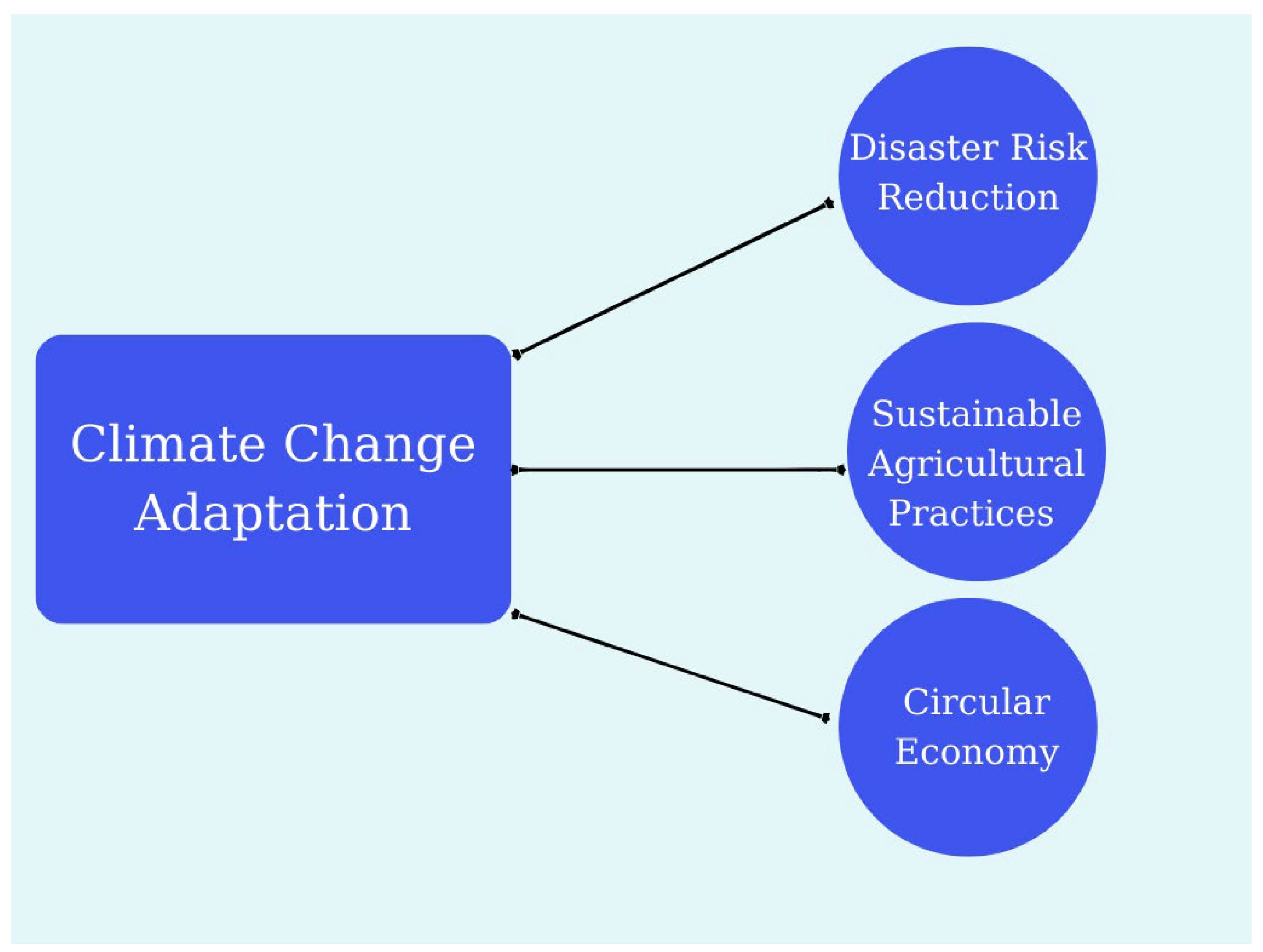
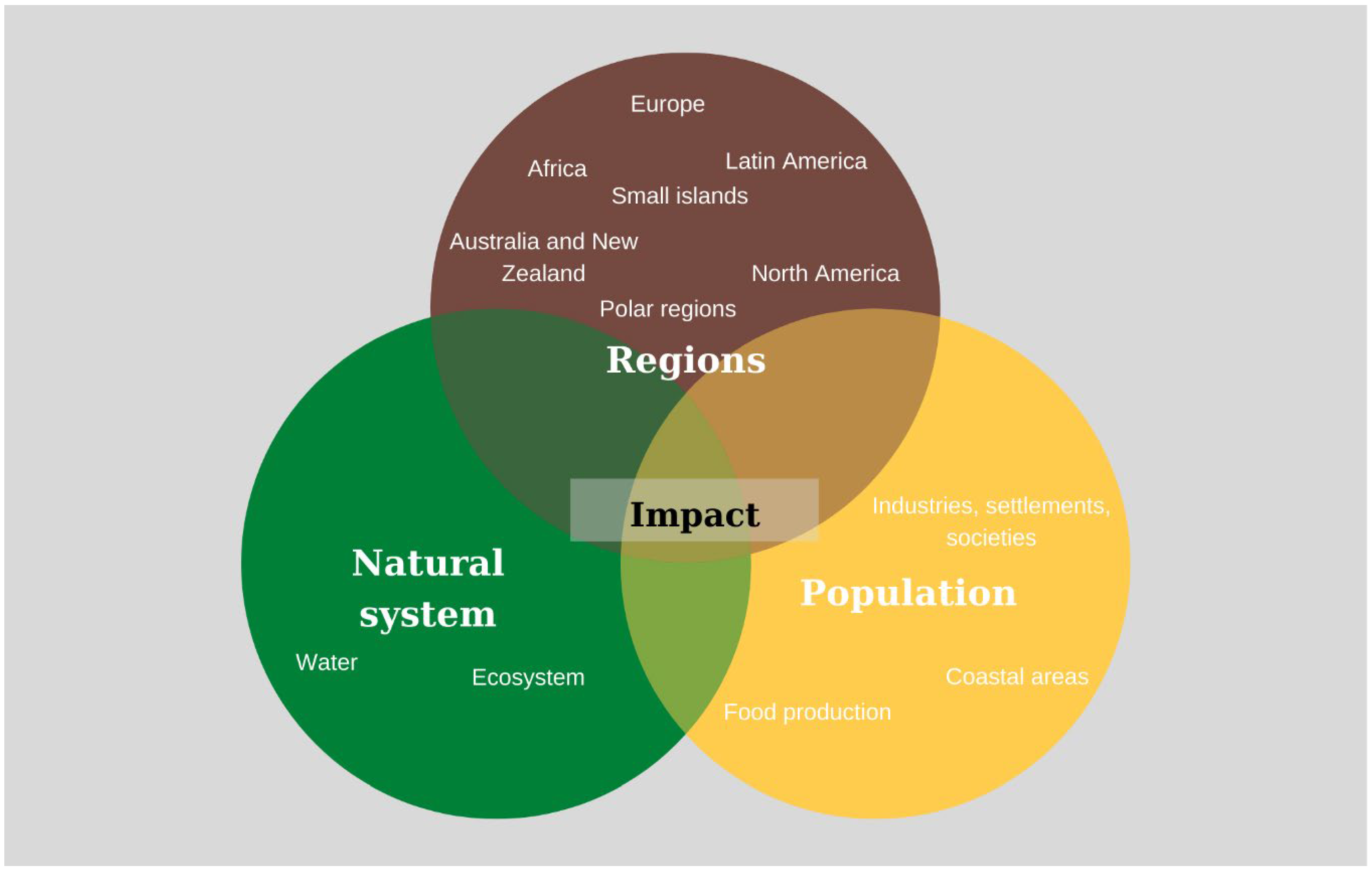
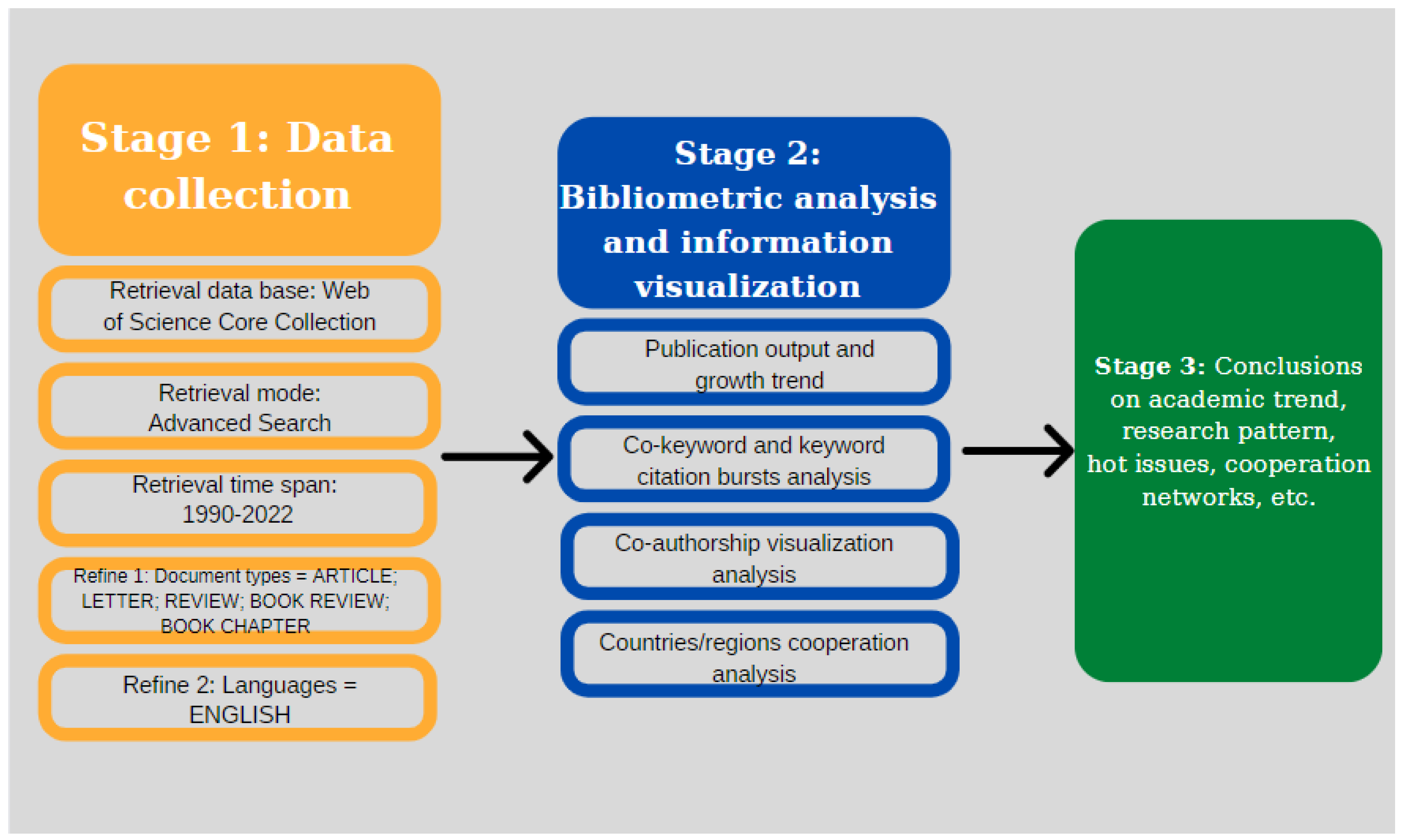
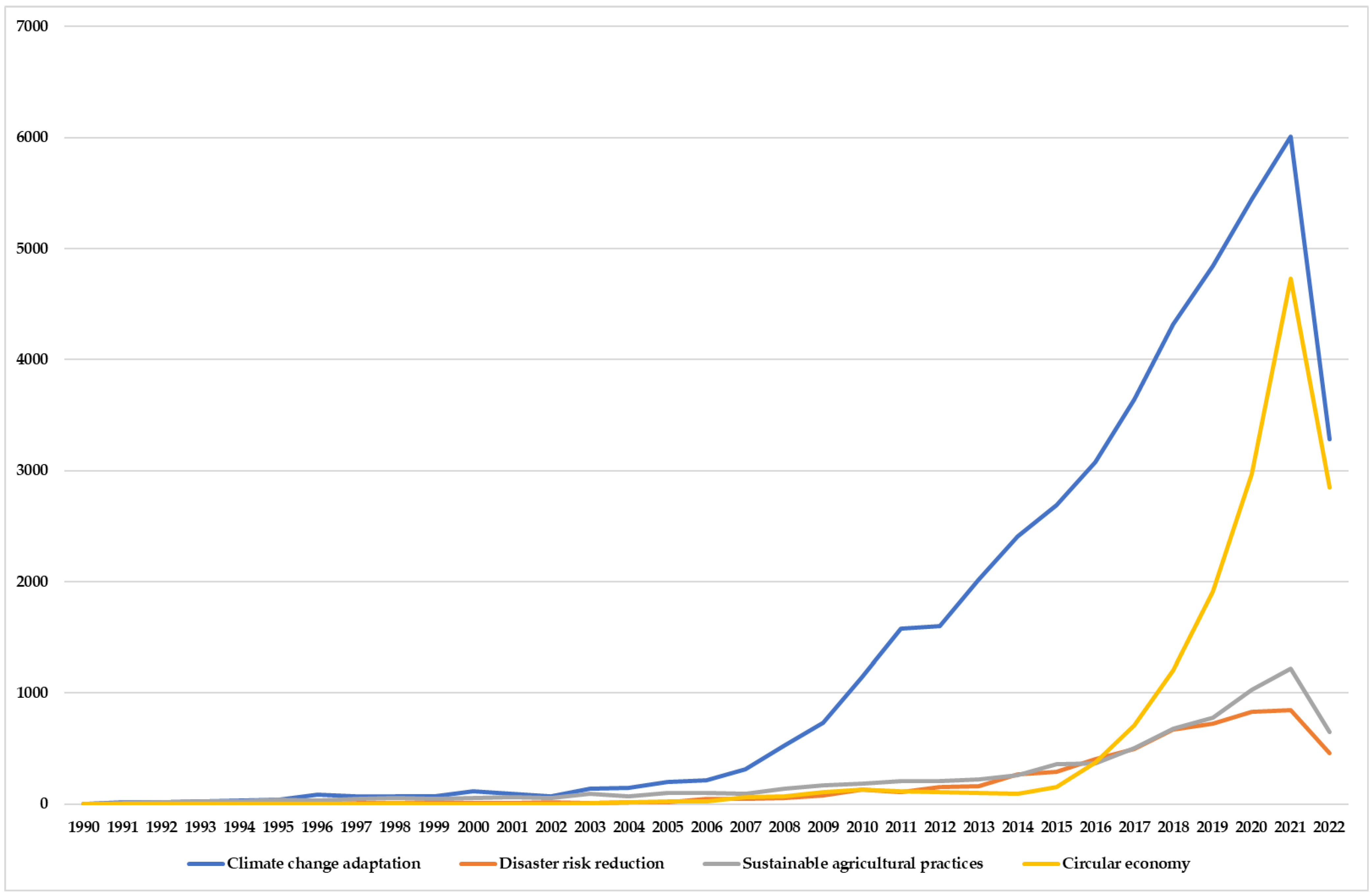
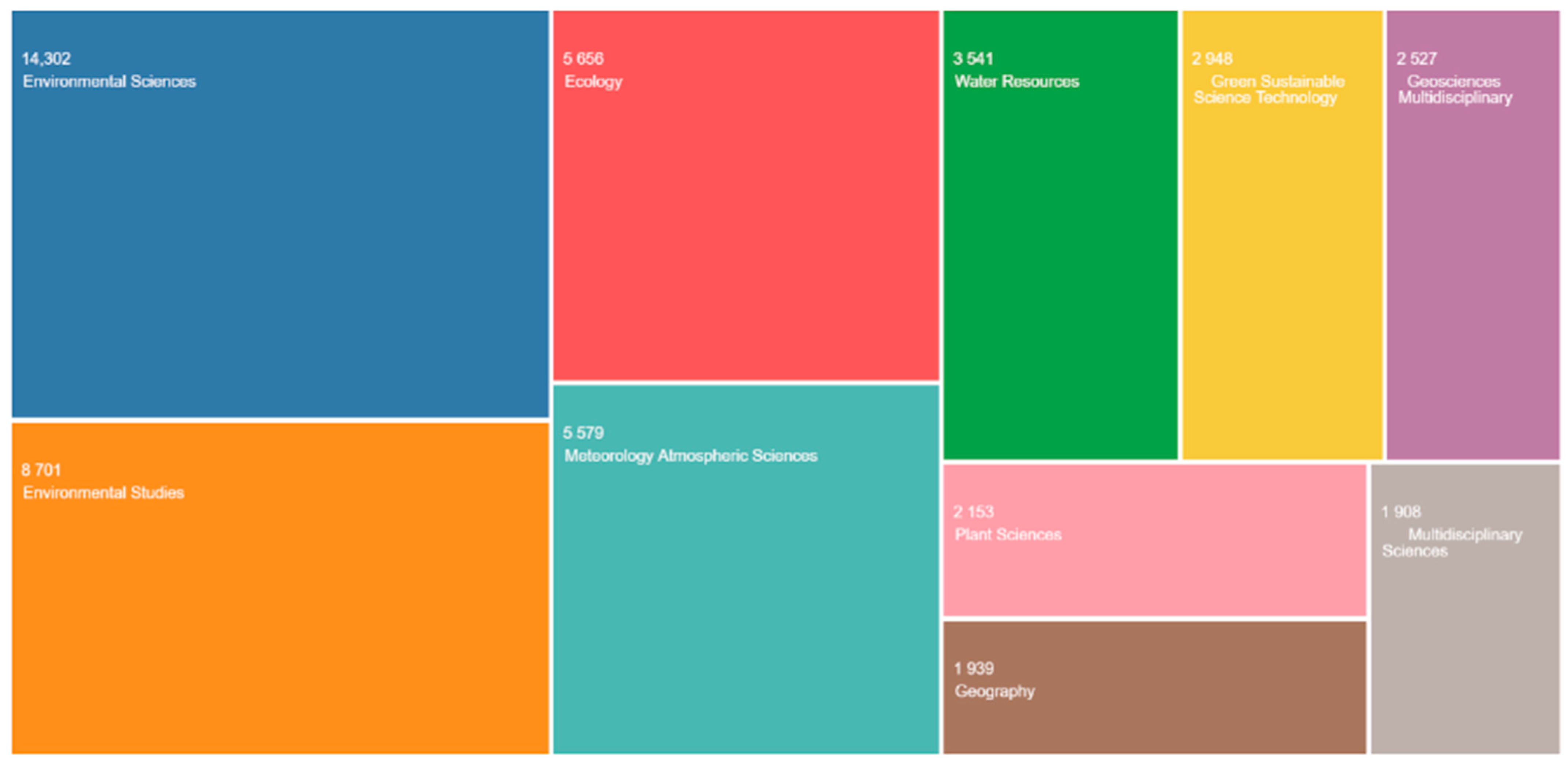
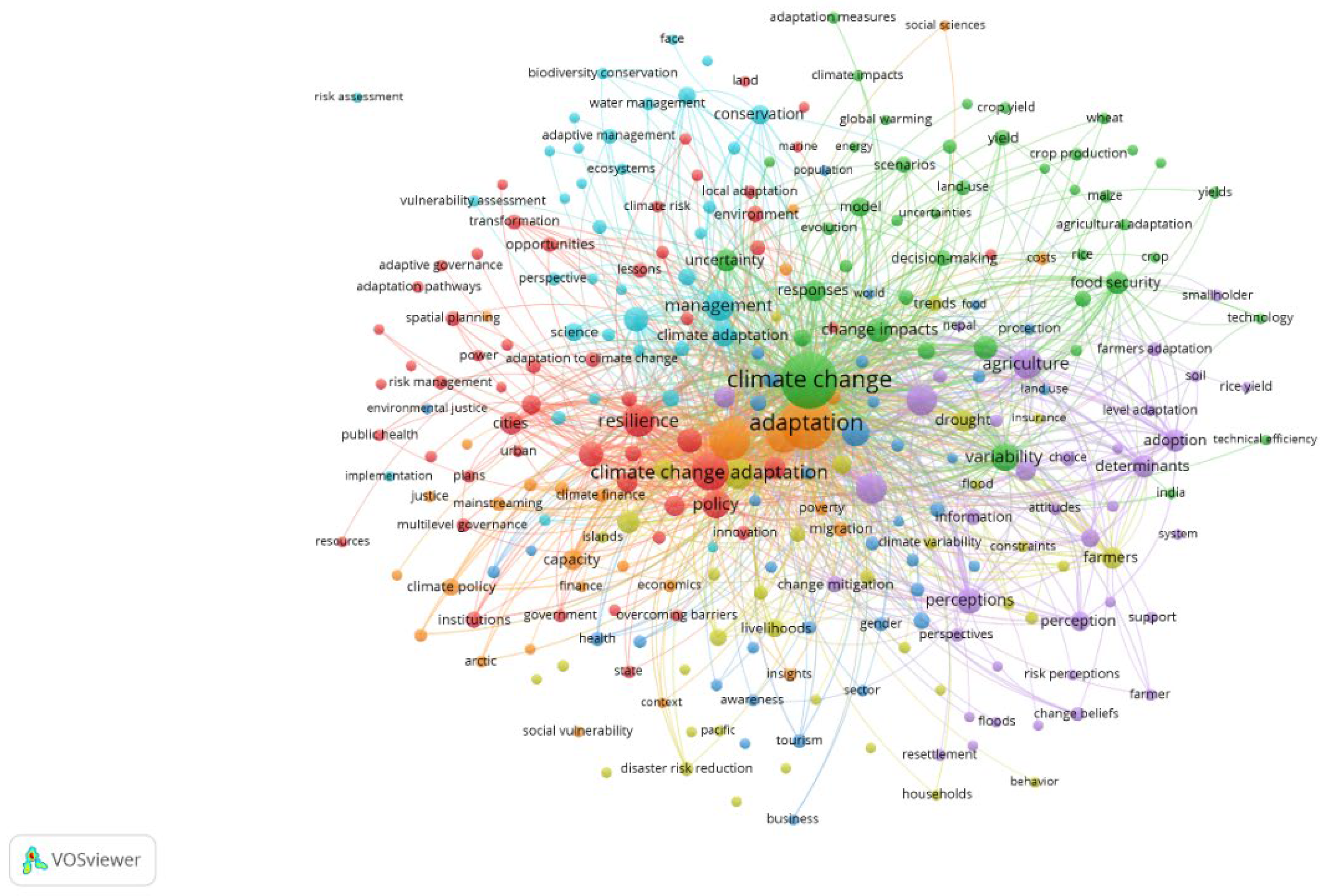
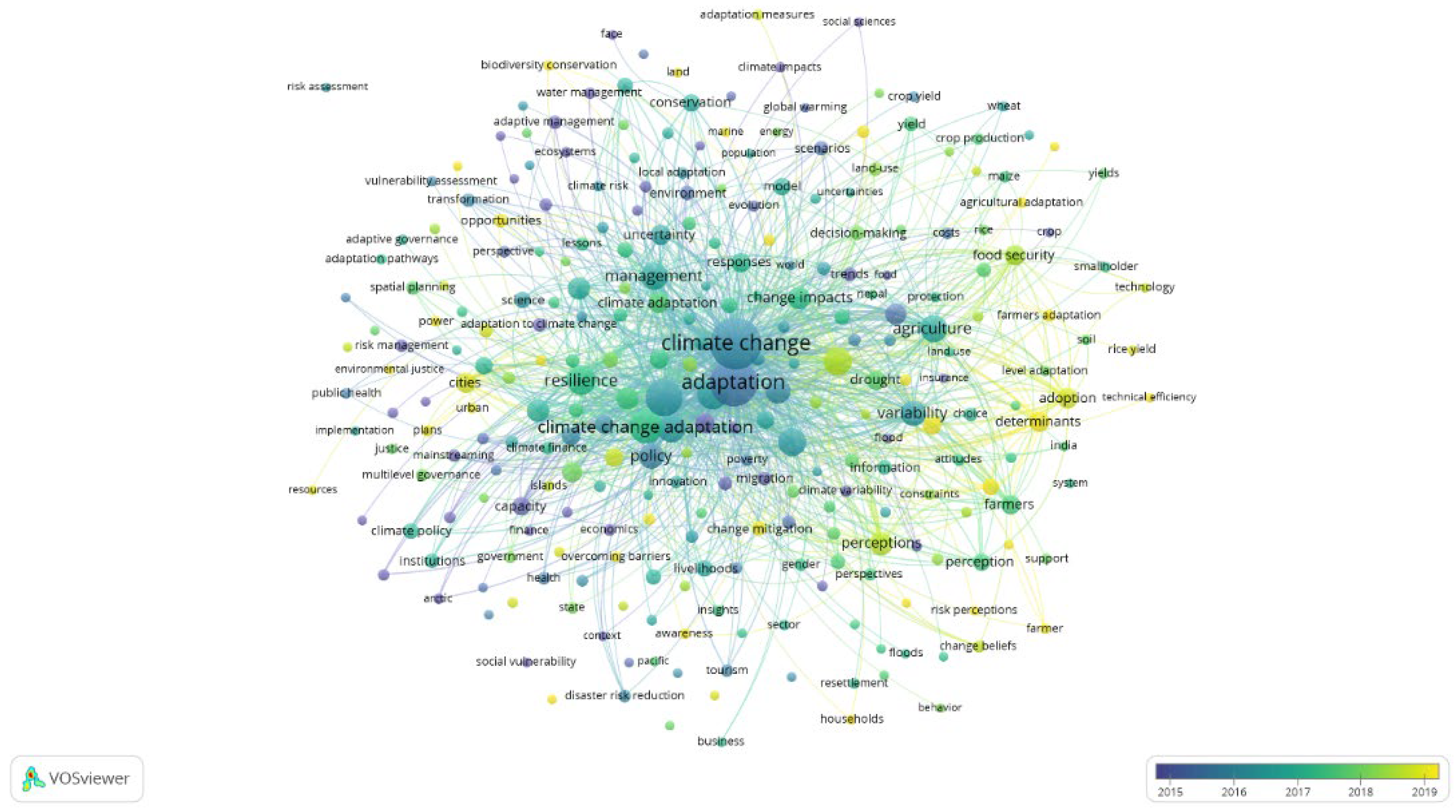
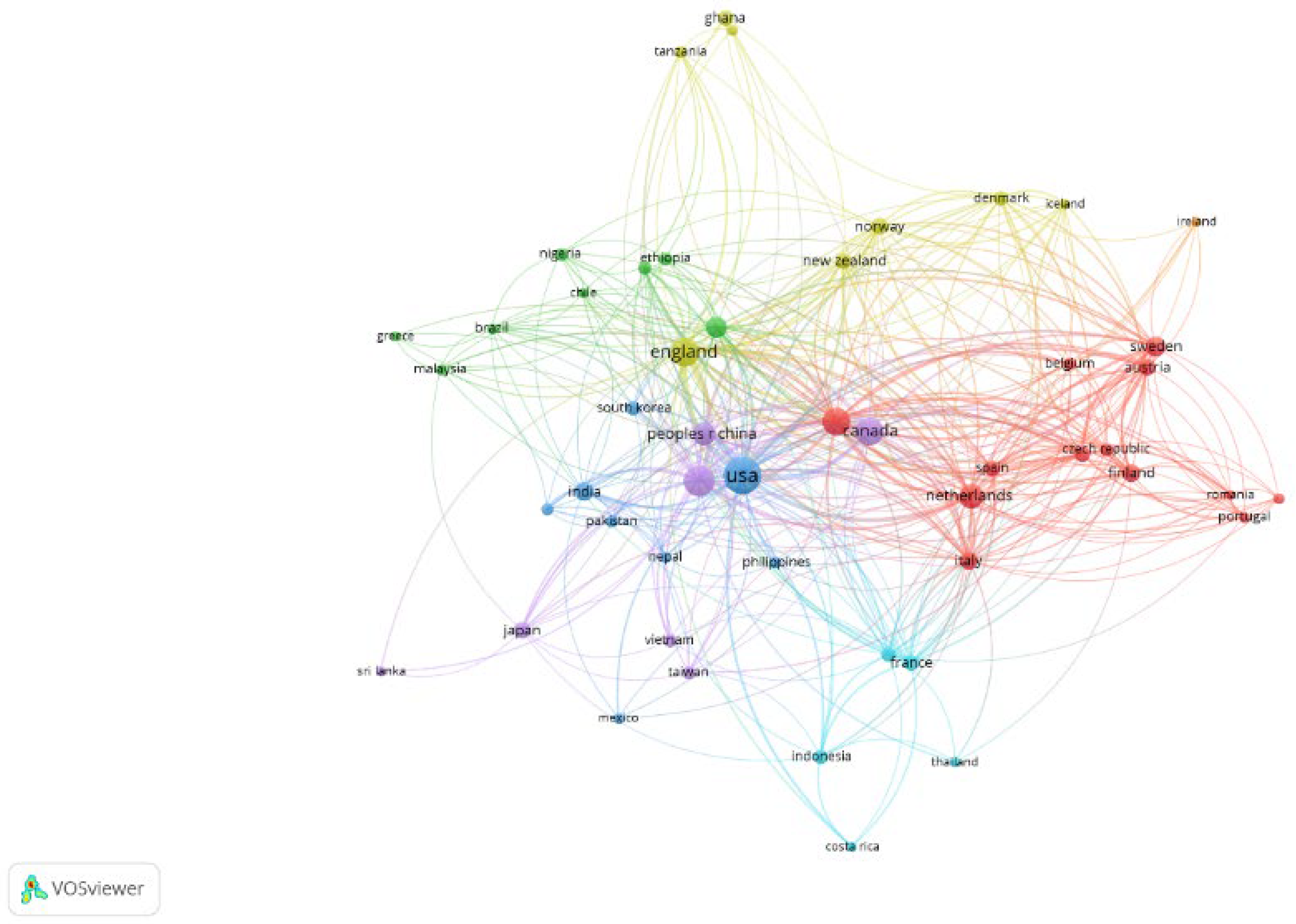
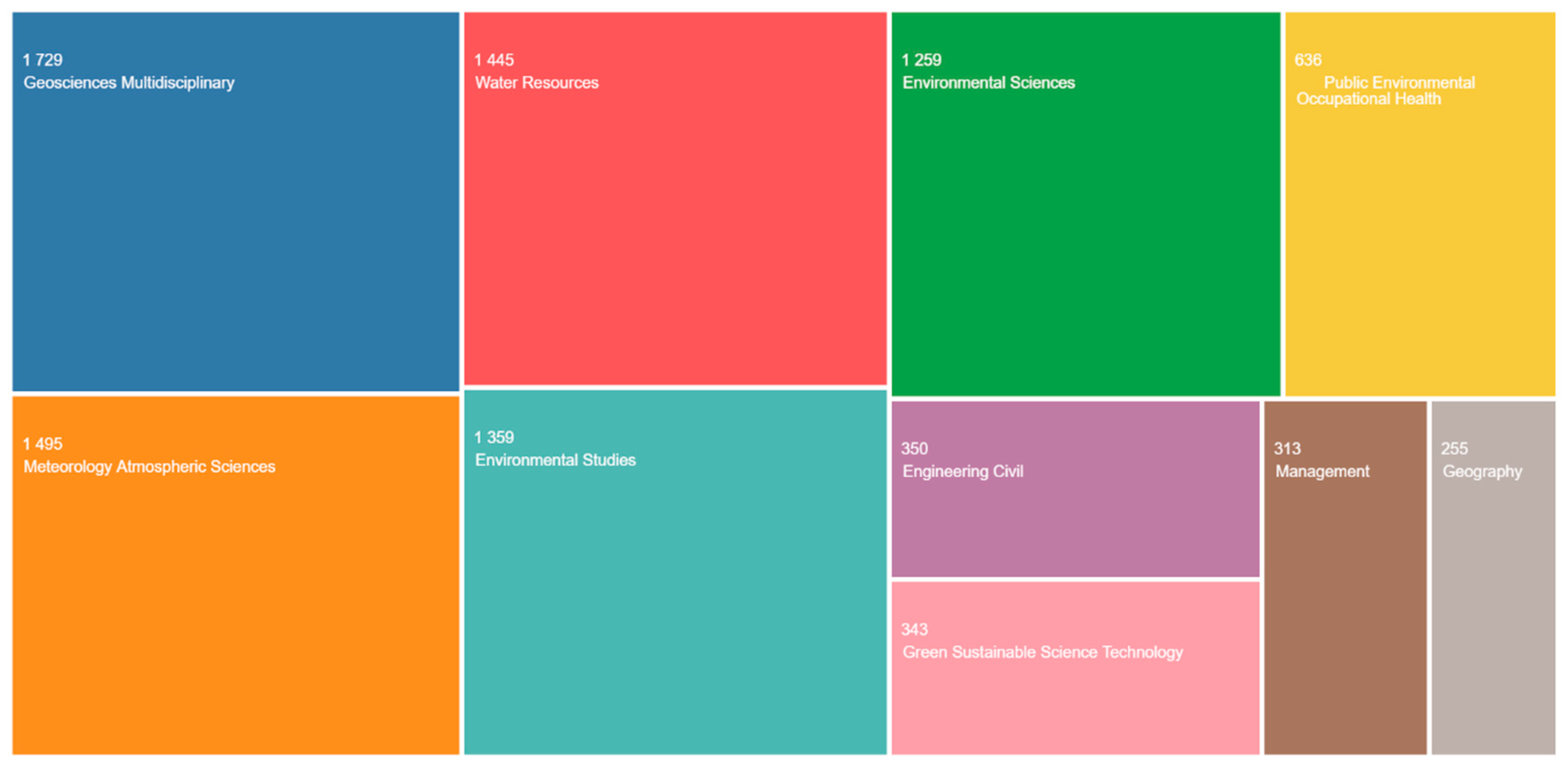
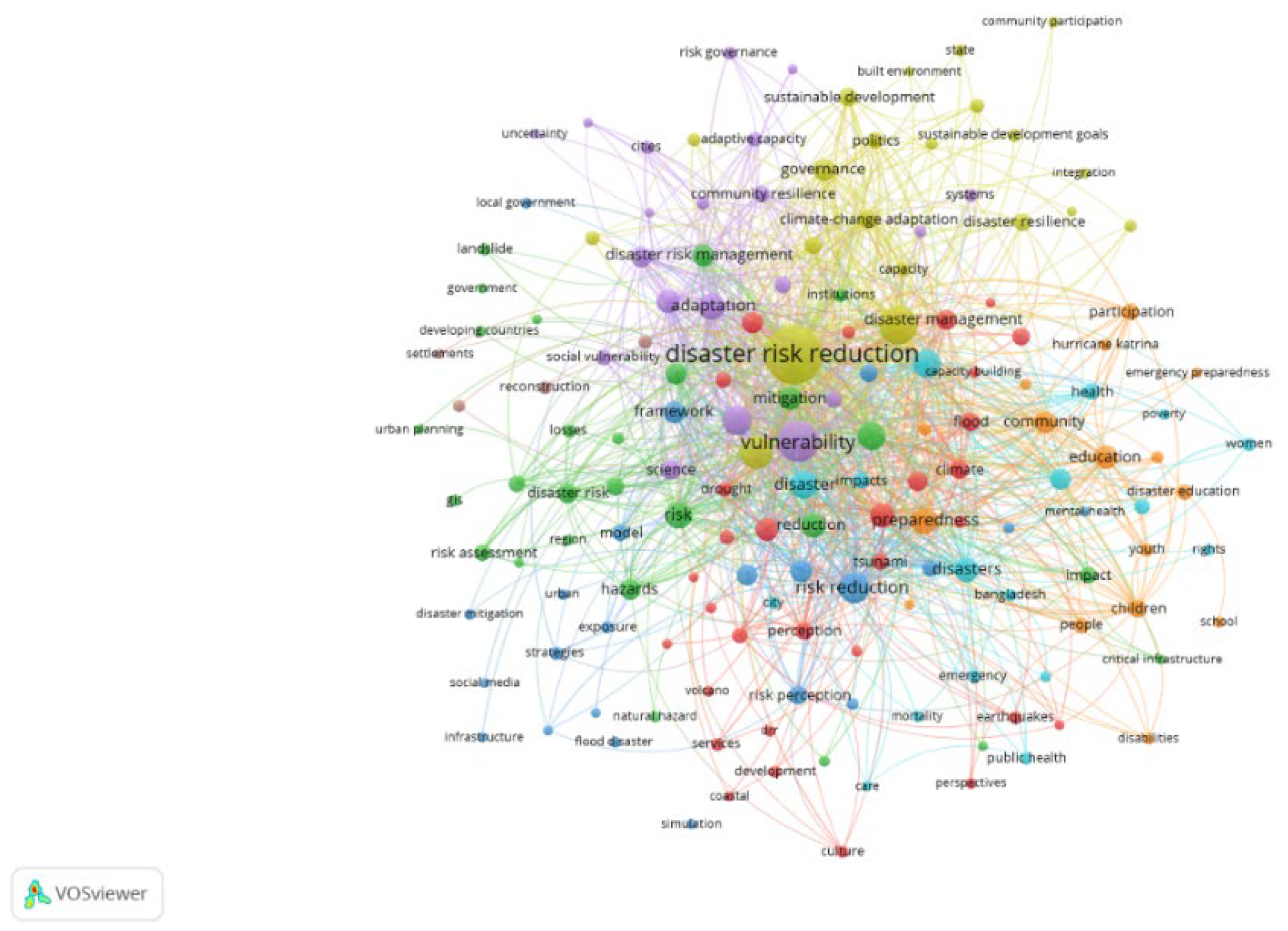
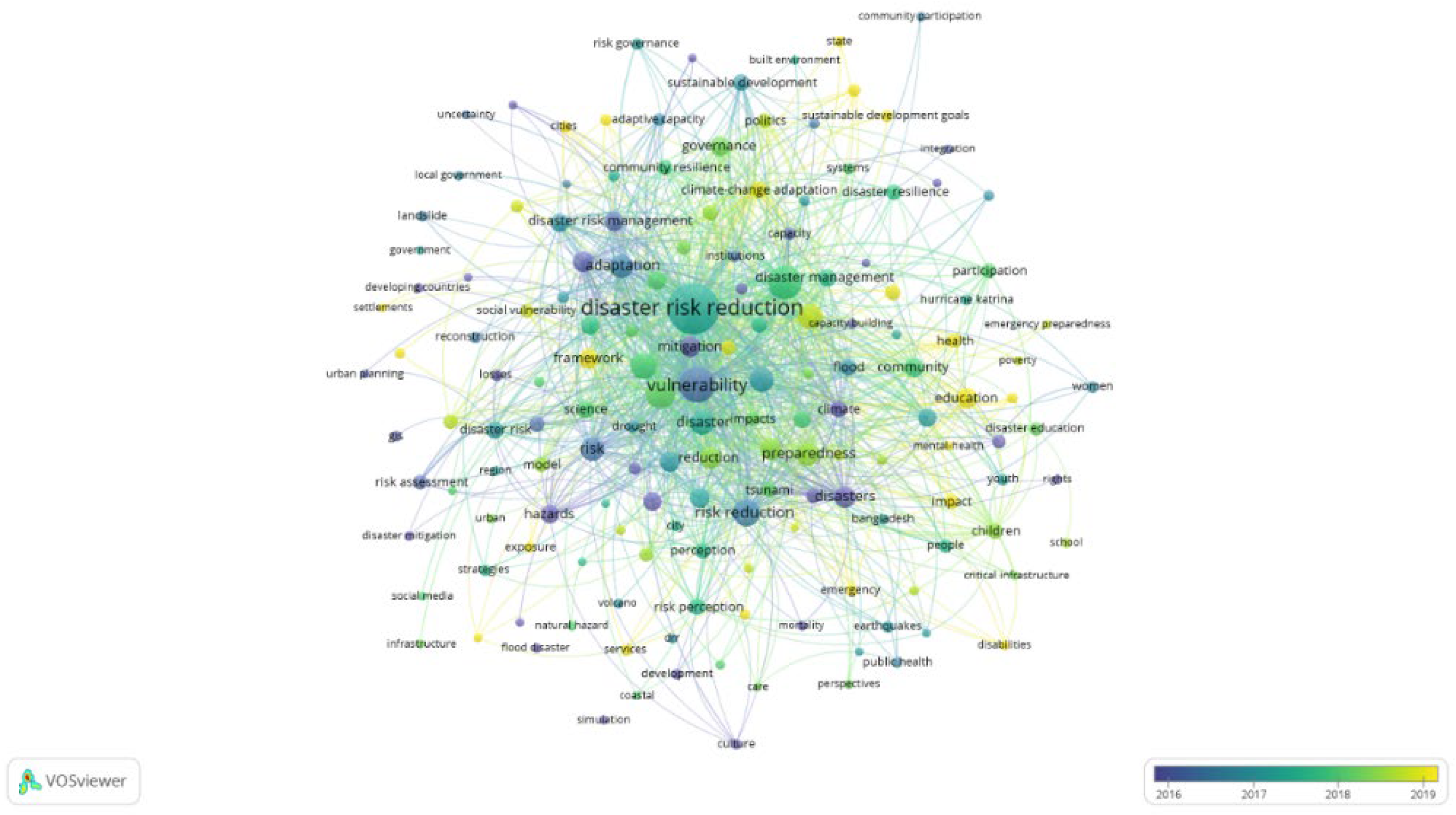
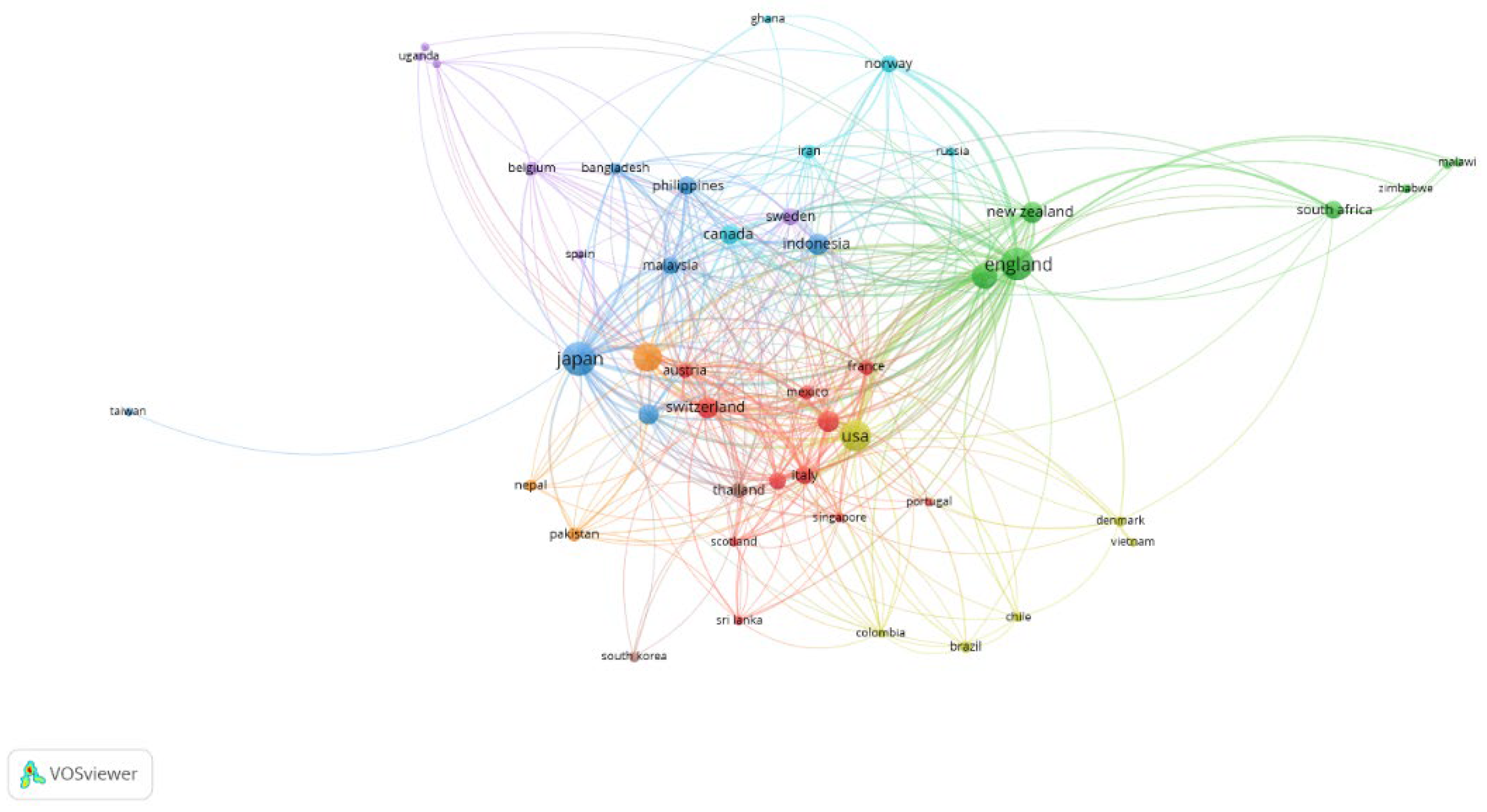

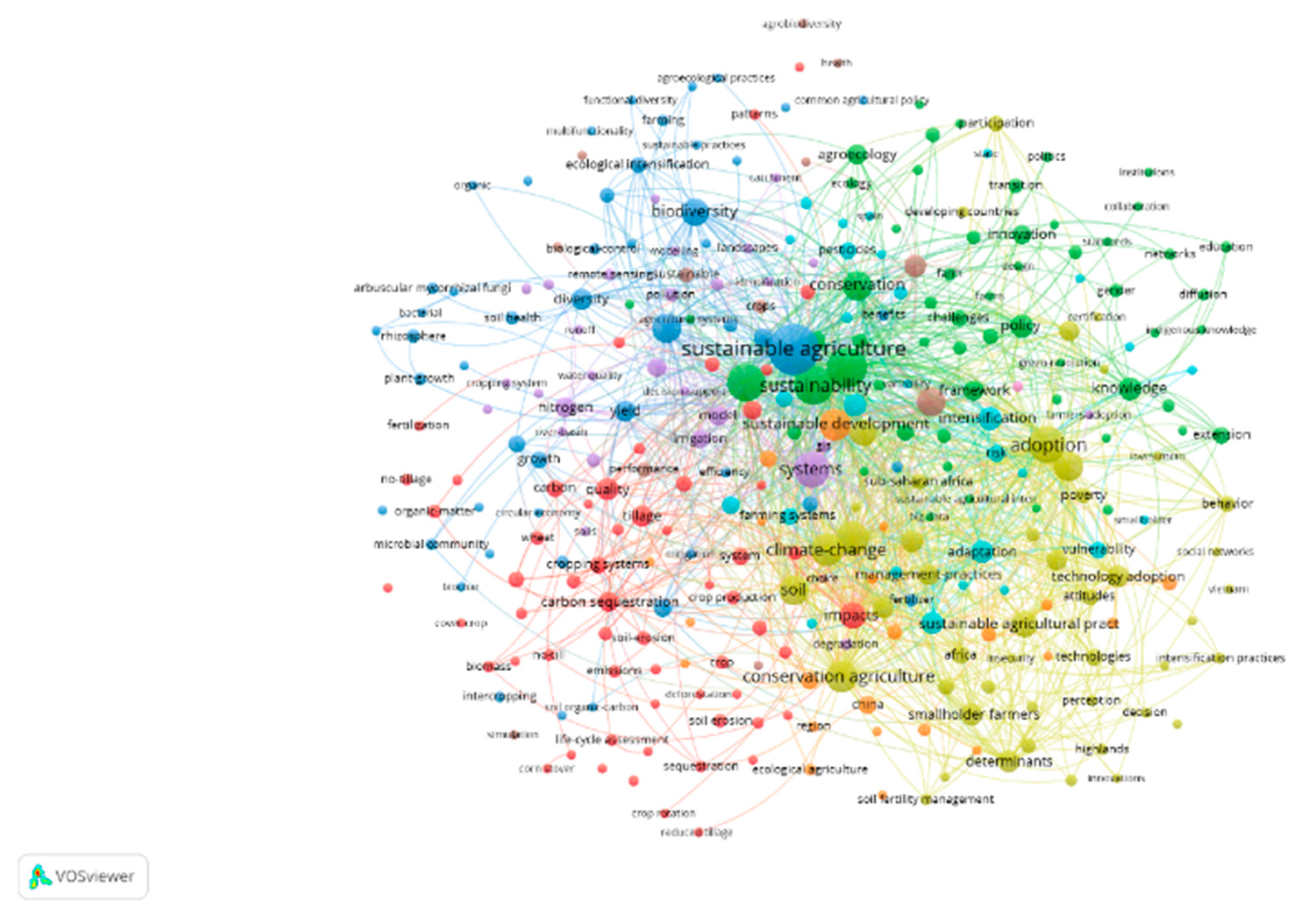
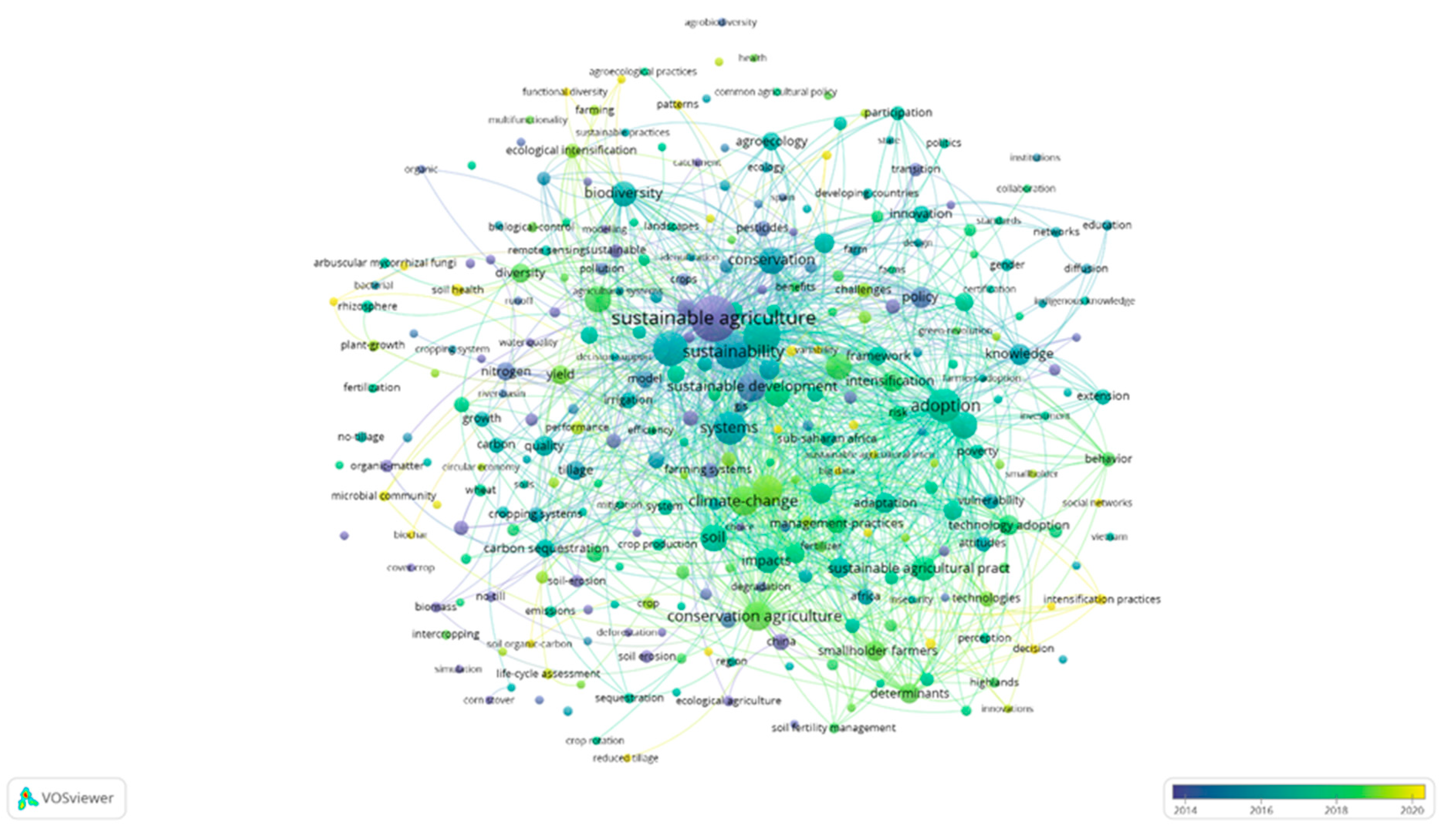
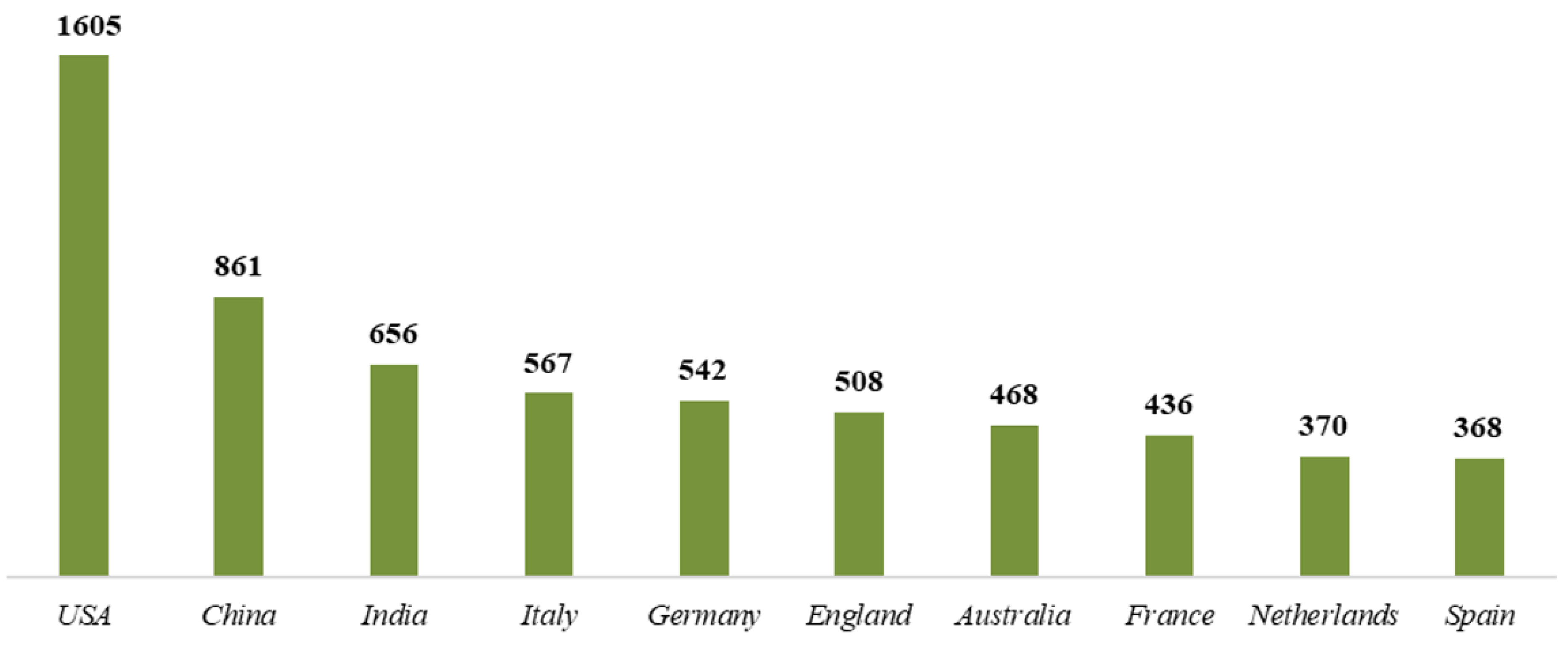
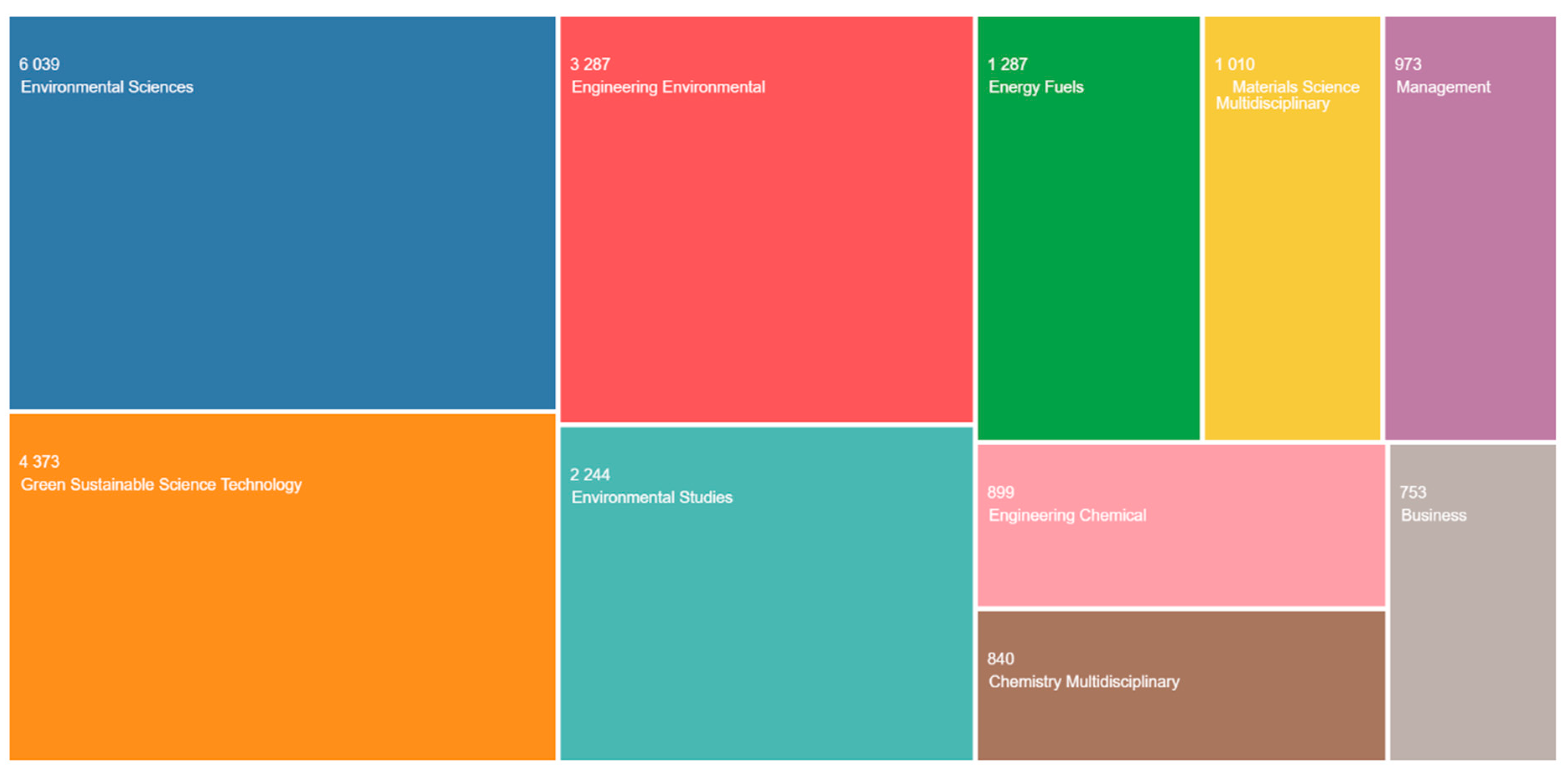
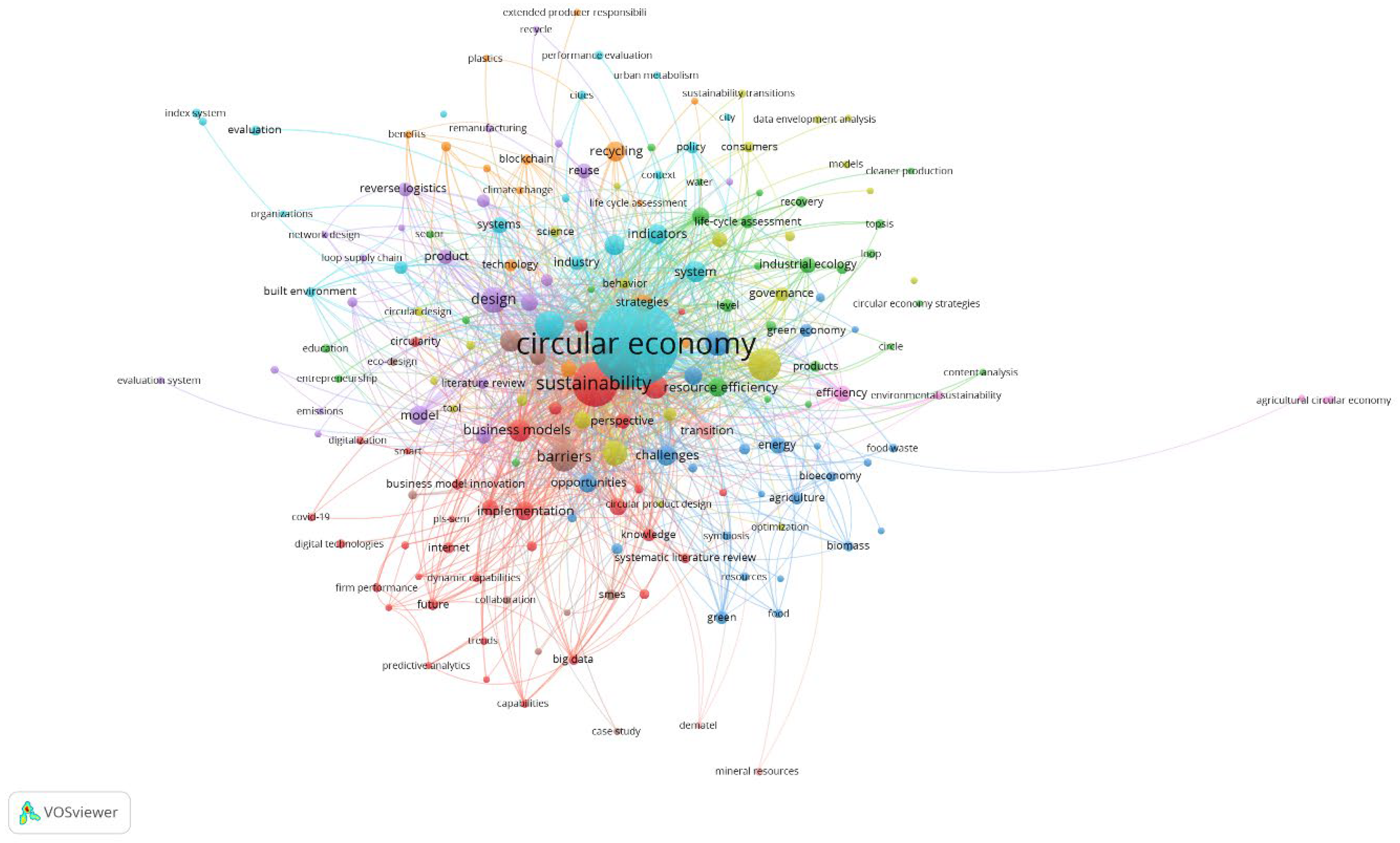
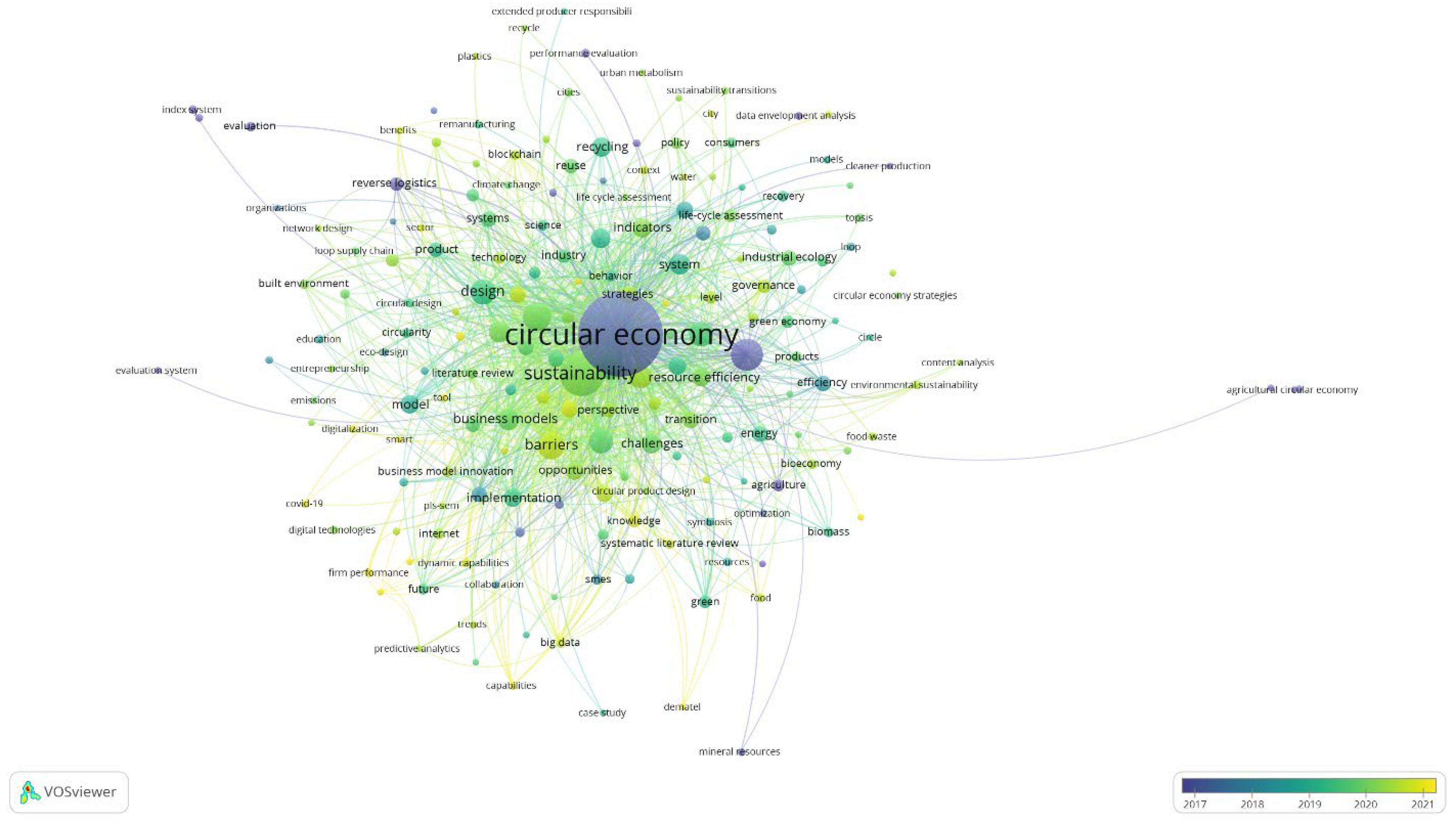
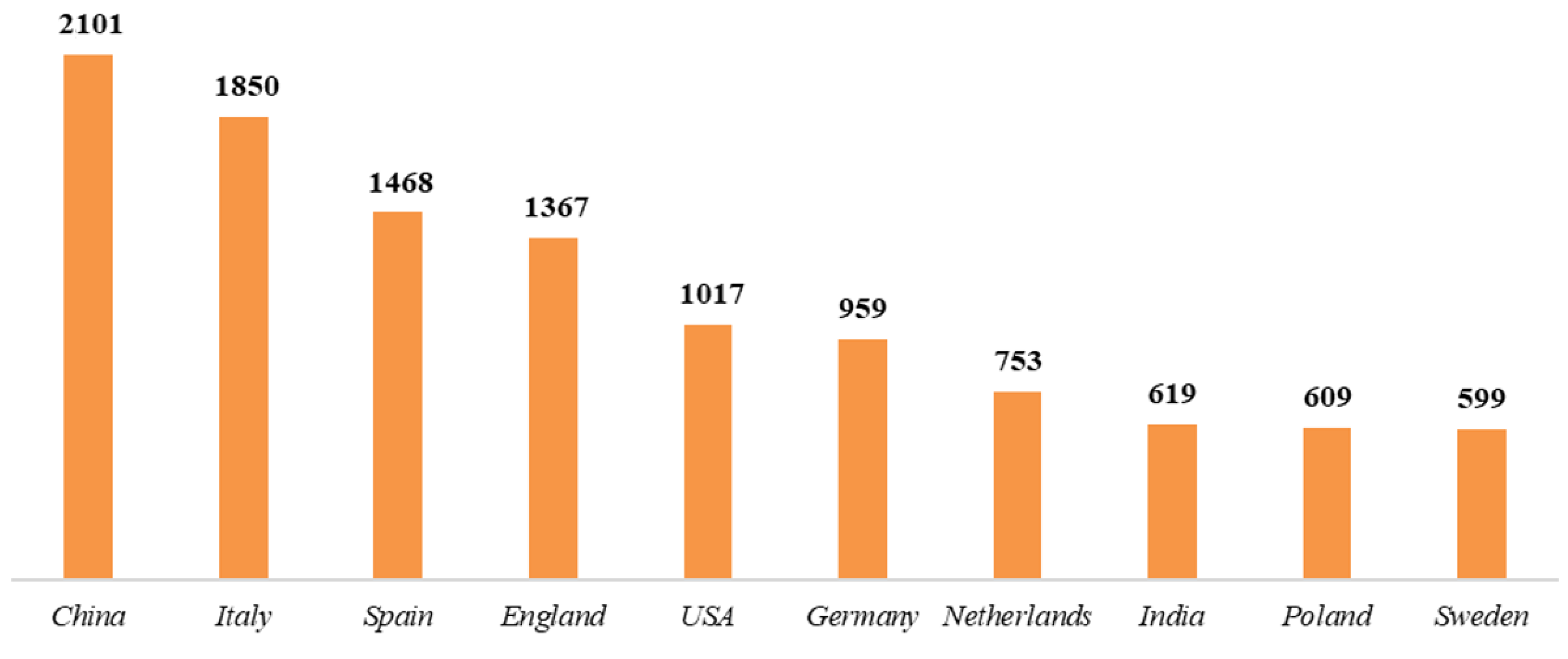
| Criterion | Topics | Justification |
|---|---|---|
| 1 | climate change adaptation | Most scientists believe that even if efforts are made to reduce emissions, even with concrete results, some climate change is inevitable, a first necessary step is to adapt to its effects [1,2]. |
| 2 | disaster risk reduction | One of the effects of climate change is the disasters caused by these effects, which have resulted in numerous losses of life and property [11,17]. |
| 3 | sustainable agricultural practices | In 2019, agriculture accounted for a 10.55% share of EU greenhouse gas emissions among all economic sectors. Given this high share, researchers have deemed it necessary to identify environmentally friendly agricultural practices [49]. |
| 4 | circular economy | As the world’s population tends to grow, the demand for raw materials and finished products is increasing, with a major impact on the environment [52]. |
| N | Minimum | Maximum | Sum | Mean | Std. Deviation | Skewness | Kurtosis | |||
|---|---|---|---|---|---|---|---|---|---|---|
| Statistic | Statistic | Statistic | Statistic | Statistic | Statistic | Statistic | Std. Error | Statistic | Std. Error | |
| Climate change adaptation | 33 | 2 | 6008 | 45,030 | 1364.55 | 1806.855 | 1.272 | 0.409 | 0.471 | 0.798 |
| Disaster risk reduction | 32 | 1 | 850 | 5920 | 185.00 | 264.795 | 1.509 | 0.414 | 1.053 | 0.809 |
| Sustainable agricultural practices | 33 | 4 | 1223 | 7940 | 240.61 | 306.928 | 1.892 | 0.409 | 3.084 | 0.798 |
| Circular economy | 33 | 1 | 4730 | 15,813 | 479.18 | 1084.104 | 2.785 | 0.409 | 7.672 | 0.798 |
Publisher’s Note: MDPI stays neutral with regard to jurisdictional claims in published maps and institutional affiliations. |
© 2022 by the authors. Licensee MDPI, Basel, Switzerland. This article is an open access article distributed under the terms and conditions of the Creative Commons Attribution (CC BY) license (https://creativecommons.org/licenses/by/4.0/).
Share and Cite
Iancu, T.; Tudor, V.C.; Dumitru, E.A.; Sterie, C.M.; Micu, M.M.; Smedescu, D.; Marcuta, L.; Tonea, E.; Stoicea, P.; Vintu, C.; et al. A Scientometric Analysis of Climate Change Adaptation Studies. Sustainability 2022, 14, 12945. https://doi.org/10.3390/su141912945
Iancu T, Tudor VC, Dumitru EA, Sterie CM, Micu MM, Smedescu D, Marcuta L, Tonea E, Stoicea P, Vintu C, et al. A Scientometric Analysis of Climate Change Adaptation Studies. Sustainability. 2022; 14(19):12945. https://doi.org/10.3390/su141912945
Chicago/Turabian StyleIancu, Tiberiu, Valentina Constanta Tudor, Eduard Alexandru Dumitru, Cristina Maria Sterie, Marius Mihai Micu, Dragos Smedescu, Liviu Marcuta, Elena Tonea, Paula Stoicea, Catalin Vintu, and et al. 2022. "A Scientometric Analysis of Climate Change Adaptation Studies" Sustainability 14, no. 19: 12945. https://doi.org/10.3390/su141912945
APA StyleIancu, T., Tudor, V. C., Dumitru, E. A., Sterie, C. M., Micu, M. M., Smedescu, D., Marcuta, L., Tonea, E., Stoicea, P., Vintu, C., Jitareanu, A. F., & Costuleanu, L. C. (2022). A Scientometric Analysis of Climate Change Adaptation Studies. Sustainability, 14(19), 12945. https://doi.org/10.3390/su141912945








